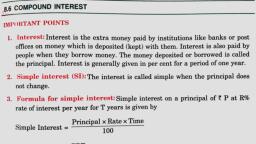Question 1 :
If the roots of ax<sup>2</sup> + bx + c = 0 are in the ratio m : n, then-<br>
Question 2 :
If the sum of squares of roots of equation <br>x<sup>2</sup> - (sin α -2) x - (1 + sin α) = 0 is the least, then α is equal <br>to -<br>
Question 3 :
The value of {tex} \sum _ { k = 1 } ^ { 10 } \left( \sin \frac { 2 k \pi } { 11 } + i \cos \frac { 2 k \pi } { 11 } \right) {/tex} is
Question 4 :
If one root of the equations ax<sup>2</sup> + bx + c = 0 and <br>bx<sup>2</sup> + cx + a = 0 (a, b, c ∈ R) is common, then the value of <br><img style='object-fit:contain' src='https://storage.googleapis.com/teachmint/question_assets/JEE%20Main/5e7463db4b0dee620420687d' height='49' width='88' >is:<br>
Question 5 :
If {tex} w = \alpha + i \beta , {/tex} where {tex} \beta \neq 0 {/tex} and {tex} z \neq 1 , {/tex} satisfies the condition that {tex} \left( \frac { w - \overline { W } z } { 1 - z } \right) {/tex} is purely real, then the set of values of {tex} z {/tex} is
Question 6 :
The number of complex numbers {tex} z {/tex} satisfying {tex} | z - 3 - i | = | z - 9 - i | {/tex} and {tex} | z - 3 + 3 i | = 3 {/tex} are
Question 7 :
If b > a, then the equation (x - a) (x - b) - 1 = 0, has-<br>
Question 8 :
The values of {tex} a {/tex} for which the equation {tex} 2 x ^ { 2 } - 2 ( 2 a + 1 ) x + a ( a - 1 ) = 0 {/tex} has roots {tex} \alpha {/tex} and {tex} \beta {/tex} where {tex} \alpha < a < {/tex} {tex} \beta {/tex} are such that
Question 9 :
Let {tex} C _ { 1 } {/tex} and {tex} C _ { 2 } {/tex} are concentric circles of radius {tex}1{/tex} and {tex} 8 / 3 , {/tex} respectively, having centre at {tex} ( 3,0 ) {/tex} on the Argand plane. If the complex number {tex} z {/tex} satisfies the inequality<br>{tex} \log _ { 1 / 3 } \left( \frac { | z - 3 | ^ { 2 } + 2 } { 11 | z - 3 | - 2 } \right) > 1 {/tex} then<br>
Question 10 :
Solution set of <img style='object-fit:contain' src='https://storage.googleapis.com/teachmint/question_assets/JEE%20Main/5e746439cae19162cd5e260a' height='43' width='119' >≥ 0 is <br>
Question 11 :
Given {tex} z {/tex} is a complex number with modulus {tex} 1 . {/tex} Then the equation {tex} [ ( 1 + i a ) / ( 1 - i a ) ] ^ { 4 } = z {/tex} has
Question 12 :
Product of real roots of the equation<br> {tex}\mathrm{x ^ { 2 } + | x | + 9 = 0}{/tex}
Question 13 :
If sin θ and cos θ are the roots of the equation <br>lx<sup>2</sup> + mx + n = 0, then -<br>
Question 14 :
The equation <img style='object-fit:contain' src='https://storage.googleapis.com/teachmint/question_assets/JEE%20Main/5e7463ef4b0dee62042068ac' height='35' width='15' >log (x<sup>2</sup> + 2x) - log <img style='object-fit:contain' src='https://storage.googleapis.com/teachmint/question_assets/JEE%20Main/5e7463d34b0dee6204206872' height='21' width='41' >= 0 has the solution -<br>
Question 15 :
If {tex} | z - 4 | < | z - 2 | , {/tex} its solution is given by
Question 16 :
Let {tex} \left| z _ { r } - r \right| \leq r , \forall r = 1,2,3 , \ldots , n . {/tex} Then {tex} \left| \sum _ { r = 1 } ^ { n } z _ { r } \right| {/tex} is less than
Question 17 :
The number of real values of the parameter k for which <br>(log<sub>16</sub>x)<sup>2</sup> - (log<sub>16</sub>x) + (log<sub>16 </sub>k) = 0 with real coefficients will <br>have exactly one solution is -<br>
Question 18 :
The number of real roots of the quadratic equation {tex} \sum _ { k = 1 } ^ { n } ( x - k ) ^ { 2 } = 0 ( n > 1 ) {/tex} is
Question 19 :
The equation sin x = x<sup>2</sup> + x + 1 has-<br>
Question 20 :
The number of real roots of <img style='object-fit:contain' src='https://storage.googleapis.com/teachmint/question_assets/JEE%20Main/5e7463fd4b0dee62042068ca' height='44' width='108' >= 0 is-<br>
Question 21 :
No. of real solutions of |x| + 2<img style='object-fit:contain' src='https://storage.googleapis.com/teachmint/question_assets/JEE%20Main/5e7463adcae19162cd5e24ce' height='25' width='75' >= 16 is /are<br>
Question 22 :
Two real numbers α and β are such that α + β = 3 & |α - β| = 4, then α&β are the roots of the quadratic equation - <br>
Question 23 :
The remainder obtained when the polynomial x + x<sup>3</sup> + x<sup>9</sup> + x<sup>27</sup> + x<sup>81</sup> + x<sup>243</sup> is divided by x<sup>2</sup> -1 is:<br>
Question 24 :
If {tex} | z | < \sqrt { 2 } - 1 , {/tex} then {tex} \left| z ^ { 2 } + 2 z \cos \alpha \right| {/tex} is
Question 25 :
If {tex} 8 i z ^ { 3 } + 12 z ^ { 2 } - 18 z + 27 i = 0 , {/tex} then
Question 27 :
If the equation {tex} a x ^ { 2 } + b x + 6 = 0 {/tex} does not have two distinct real roots, then the least value of {tex} 3 a + b {/tex} is
Question 29 :
The locus of point {tex} z {/tex} satisfying {tex} \operatorname { Re } \left( \frac { 1 } { z } \right) = k , {/tex} where {tex} k {/tex} is a non- zero real number, is
Question 30 :
Let a, b, c be three real numbers such that 2a + 3b + 6c = 0. Then the quadratic equation ax<sup>2</sup> + bx + c = 0 has -<br>
Question 31 :
If a complex number {tex} x {/tex} satisfies {tex} \log _ { 1 / \sqrt { 2 } } \left( \frac { | z | ^ { 2 } + 2 | z | + 6 } { 2 | z | ^ { 2 } - 2 | z | + 1 } \right) < 0 , {/tex} then locus/region of the point represented by z is
Question 32 :
If p and q are the roots of the equation x<sup>2</sup> + px + q = 0, then<br>
Question 34 :
If {tex} p {/tex} and {tex} q {/tex} are the roots of the equation {tex} x ^ { 2 } + p x + q = 0 , {/tex} then
Question 35 :
The largest negative integer which satisfies <img style='object-fit:contain' src='https://storage.googleapis.com/teachmint/question_assets/JEE%20Main/5e746431aed3b3628524487f' height='43' width='77' >> 0 is -<br>
Question 36 :
If x, y are rational numbers such that (x + y) + (x - 2y) <img style='object-fit:contain' src='https://storage.googleapis.com/teachmint/question_assets/JEE%20Main/5e7462cbaed3b362852445ec' height='21' width='23' > = 2x - y + (x - y - 1) <img style='object-fit:contain' src='https://storage.googleapis.com/teachmint/question_assets/JEE%20Main/5e7463d2cae19162cd5e251f' height='23' width='21' > then -<br>
Question 37 :
If no zero of the quadratic expression ax<sup>2</sup> - 2bx - 3 is real. Then the value of a + 2b is<br>
Question 38 :
If {tex} z = ( \lambda + 3 ) - i \sqrt { 5 - \lambda ^ { 2 } } , {/tex} then the locus of {tex} z {/tex} is
Question 39 :
If x<sup>2 </sup>- 4x + log<sub>1/2</sub>a = 0 does not have two distinct real roots, then maximum value of a is<br>
Question 40 :
The solution set of <img style='object-fit:contain' src='https://storage.googleapis.com/teachmint/question_assets/JEE%20Main/5e74642ecae19162cd5e25e9' height='41' width='36' > + |x| = <img style='object-fit:contain' src='https://storage.googleapis.com/teachmint/question_assets/JEE%20Main/5e74642eaed3b36285244876' height='41' width='41' > is :<br>
Question 41 :
If roots of the equation 3x<sup>2</sup> + 2(a<sup>2</sup> + 1) x + (a<sup>2</sup> - 3a + 2) = 0 are of opposite signs, then a lies in the interval -<br>
Question 42 :
If <img style='object-fit:contain' src='https://storage.googleapis.com/teachmint/question_assets/JEE%20Main/5e7463b74b0dee6204206837' height='25' width='69' >> x - 4 then -<br>
Question 43 :
If {tex} \left| z _ { 1 } \right| = \left| z _ { 2 } \right| = \left| z _ { 3 } \right| = 1 {/tex} and {tex} z _ { 1 } + z _ { 2 } + z _ { 3 } = 0 , {/tex} then area of the triangle whose vertices are {tex} z _ { 1 } , z _ { 2 } , z _ { 3 } {/tex} is
Question 44 :
If x is real then minimum value of x<sup>2</sup> - 8x + 17 is<br>
Question 45 :
If {tex} \omega ( \neq 1 ) {/tex} is a cube root of unity, and {tex} ( 1 + \omega ) ^ { 7 } = A + B \omega . {/tex} Then {tex} ( A , B ) {/tex} equals
Question 46 :
If the roots of the equation ax<sup>2</sup> + bx + c = 0 are in the ratio m : n, then<br>
Question 47 :
For all x ∈ R, if mx<sup>2</sup> - 9mx + 5m + 1 > 0, then m lies in the interval -<br>
Question 48 :
If x<sup>2</sup> + 2ax + 10 - 3a > 0 for all x ∈ R, then -<br>
Question 49 :
The equation 3x<sup>2</sup> + 4ax + b = 0 has at least one root in (0,1) if <br>
Question 50 :
If {tex} x ^ { 2 } + 2 a x + b \geq c , \forall x \in R , {/tex} then
Question 51 :
If {tex} z ( 1 + a ) = b + i c {/tex} and {tex} a ^ { 2 } + b ^ { 2 } + c ^ { 2 } = 1 , {/tex} then {tex} [ ( 1 + i z ) / ( 1 - i z )] = {/tex}
Question 52 :
If {tex} z _ { 1 } , z _ { 2 } , z _ { 3 } {/tex} are three complex numbers and<br>{tex} A = \left| \begin{array} { l l l } { \arg z _ { 1 } } & { \arg z _ { 2 } } & { \arg z _ { 3 } } \\ { \arg z _ { 2 } } & { \arg z _ { 3 } } & { \arg z _ { 1 } } \\ { \arg z _ { 3 } } & { \arg z _ { 1 } } & { \arg z _ { 2 } } \end{array} \right| {/tex}<br>then {tex} A {/tex} is divisible by
Question 53 :
{tex} z _ { 1 } , z _ { 2 } , z _ { 3 } , z _ { 4 } {/tex} are distinct complex numbers representing the vertices of a quadrilateral {tex} A B C D {/tex} taken in order. If {tex} z _ { 1 } - z _ { 4 } = z _ { 2 } - z _ { 3 } {/tex} and {tex} \arg \left[ \left( { z _ { 4 } } - z _ { 1 } \right) / \left( z _ { 2 } - z _ { 1 } \right) \right] = \pi / 2 , {/tex} then the quadrilateral is
Question 54 :
If the difference between the roots of the equation {tex} x ^ { 2 } + a x {/tex} {tex} + 1 = 0 {/tex} is less than {tex} \sqrt { 5 } {/tex} , then the set of possible values of {tex} a {/tex} is
Question 55 :
If {tex} ( \cos \theta + i \sin \theta ) ( \cos 2 \theta + i \sin 2 \theta ) \cdots ( \cos n \theta + i \sin n \theta ) = 1 {/tex} then the value of {tex} \theta {/tex} is, {tex} m \in N {/tex}
Question 56 :
If {tex} \left( a _ { 1 } + i b _ { 1 } \right) \left( a _ { 2 } + i b _ { 2 } \right) \ldots \left( a _ { n } + i b _ { n } \right) = A + i B , {/tex} then {tex} \sum _ { j = 1 } ^ { n } \tan ^ { - 1 } \left( \frac { b _ { j } } { a _ { j } } \right) {/tex} is equal to
Question 57 :
If {tex} | z - 2 | = \min \{ | z - 1 | , | z - 3 | \} , {/tex} where {tex} z {/tex} is a complex number, then
Question 58 :
Roots of the equations are {tex} ( z + 1 ) ^ { 5 } = ( z - 1 ) ^ { 5 } {/tex} are
Question 59 :
The maximum area of the triangle formed by the complex coordinates {tex} z,z _ { 1 } , z _ { 2 } {/tex} which satisfy the relations {tex} \left| z - z _ { 1 } \right| = \left| z - z _ { 2 } \right| {/tex}
Question 60 :
Consider the equation {tex} 10 z ^ { 2 } - 3 i z - k = 0 , {/tex} where {tex} z {/tex} is a complex variable and {tex} i ^ { 2 } = - 1 . {/tex} Which of the following statements is true?
Question 61 :
Number of complex numbers {tex} z {/tex} such that {tex} | z | = 1 {/tex} and {tex} | z / \bar { z } + \bar { z } / z | {/tex} {tex} = 1 {/tex} is {tex} ( \arg ( z ) \in [ 0,2 \pi ) ) {/tex}
Question 62 :
The greatest positive argument of complex number satisfying {tex} | z - 4 | = \operatorname { Re } ( z ) {/tex} is
Question 63 :
The number of solutions of the equation {tex} z ^ { 2 } + \bar { z } = 0 {/tex} is
Question 64 :
Dividing {tex} f ( z ) {/tex} by {tex} z - i , {/tex} we obtain the remainder {tex} i {/tex} and dividing it by {tex} z + i , {/tex} we get the remainder {tex} 1 + i , {/tex} then remainder upon the division of {tex} f ( z ) {/tex} by {tex} z ^ { 2 } + 1 {/tex} is
Question 65 :
If {tex} |2 z - 1| = | z - 2 | {/tex} and {tex} z _ { 1 } , z _ { 2 } , z _ { 3 } {/tex} are complex numbers such that {tex} \left| z _ { 1 } - \alpha \right| < \alpha , \left| z _ { 2 } - \beta \right| < \beta , {/tex} then {tex} \left| \frac { z _ { 1 } + z _ { 2 } } { \alpha + \beta } \right| {/tex}
Question 66 :
The maximum area of the triangle formed by the complex coordinates {tex} z , z _ { 1 } , z _ { 2 } {/tex} which satisfy the relations {tex} \left| z - z _ { 1 } \right| = \left| z - z _ { 2 } \right| {/tex} and {tex} \left| z - \left( z _ { 1 } + z _ { 2 } \right) / 2 \right| \leq r , {/tex} where {tex} r > \left| z _ { 1 } - z _ { 2 } \right| {/tex} is
Question 67 :
{tex} z _ { 1 } {/tex} and {tex} z _ { 2 } {/tex} are two distinct points in an Argand plane. If {tex} a \left| z _ { 1 } \right| = b \left| z _ { 2 } \right| {/tex} (where {tex} a , b \in R ) , {/tex} then the point {tex} \left( a z _ { 1 } / b z _ { 2 } \right) + \left( b z _ { 2 } / a z _ { 1 } \right) {/tex} is a point on the
Question 68 :
The points {tex} z _ { 1 } = 3 + \sqrt { 3 } i {/tex} and {tex} z _ { 2 } = 2 \sqrt { 3 } + 6 i {/tex} are given on a complex plane. The complex number lying on the bisector of the angle formed by the vectors {tex} z _ { 1 } {/tex} and {tex} z _ { 2 } {/tex} is
Question 69 :
The number of complex numbers satisfying {tex} | z + 2 | + | z - 2 | = 8 {/tex} and {tex} | z - 1 | + | z + 1 | = 2 {/tex} is
Question 70 :
If {tex} x = 9 ^ { 1/3 } 9 ^ { 1/9 } 9 ^ { 1/27 } \ldots .{\infty} , y = 4 ^ { 1/3 } 4 ^ { - 1/9 } 4 ^ { 1/27 } \ldots {\infty} , {/tex} and {tex} z = \sum _ { r = 1 } ^ { \infty } ( 1 + {/tex} {tex} i ) ^ { - r } , {/tex} then {tex} \arg ( x + y z ) {/tex} is equal to
Question 71 :
Locus of {tex} z {/tex} if {tex} \arg [ z - ( 1 + i ) ] = \left\{ \begin{array} { l l } { \frac { 3 \pi } { 4 } } & { \text { when } | z | \leq | z - 2 | } \\ { \frac { - \pi } { 4 } } & { \text { when } | z | > | z - 2 | } \end{array} \right. {/tex} is
Question 72 :
Suppose {tex} A {/tex} is a complex number and {tex} n \in N , {/tex} such that {tex} A ^ { n } = ( A {/tex} {tex} + 1 ) ^ { n } = 1 , {/tex} then the least value of {tex} n {/tex} is
Question 73 :
If {tex} z = \left( \frac { \sqrt { 3 } + i } { 2 } \right) ^ { 5 } + \left( \frac { \sqrt { 3 } - i } { 2 } \right) ^ { 5 } , {/tex} then
Question 74 :
Let {tex} z , w {/tex} be complex numbers such that {tex} \bar { z } + i \bar { w } = 0 {/tex} and arg {tex} z w = {/tex} {tex} \pi . {/tex} Then arg {tex} z {/tex} equals
Question 75 :
The number of real roots of equation {tex} x ^ { 8 } - x ^ { 5 } + x ^ { 2 } - x + 2 = 0 {/tex} is
Question 76 :
If {tex} \cos \alpha + 2 \cos \beta + 3 \cos \gamma = \sin \alpha + 2 \sin \beta + 3 \sin \gamma = 0 , {/tex} then the value of {tex} \sin 3 \alpha + 8 \sin 3 \beta + 27 \sin 3 \gamma {/tex} is
Question 77 :
If {tex} z = x + i y ( x , y \in R , x \neq - 1 / 2 ) , {/tex} then the number of values of {tex} z {/tex} satisfying {tex} | z | ^ { n } = z ^ { 2 } | z | ^ { n - 2 } + z | z | ^ { n - 2 } + 1 ( n \in N , n > 1 ) {/tex} is
Question 78 :
Which of the following represents a point in an Argand plane, equidistant from the roots of the equation {tex} ( z + 1 ) ^ { 4 } = 16 z ^ { 4 } ? {/tex}
Question 79 :
Let {tex} a {/tex} be a complex number such that {tex} | a | < 1 {/tex} and {tex} z _ { 1 } , z _ { 2 } , z _ { 3 } , \ldots {/tex} be the vertices of a polygon such that {tex} z _ { k } = 1 + a + a ^ { 2 } + \cdots + a ^ { k - 1 } {/tex} for all {tex} k = 1,2,3 , \ldots {/tex} then {tex} z _ { 1 } , z _ { 2 } , \ldots {/tex} lie within the circle
Question 80 :
If {tex} z _ { \mathrm { 1 } } {/tex} and {tex} z _ { 2 } {/tex} be complex numbers such that {tex} z _ { 1 } \neq z _ { 2 } {/tex} and {tex} \left| z _ { 1 } \right| = \left| z _ { 2 } \right| {/tex}. If {tex} z _ { 1 } {/tex} has positive real part and {tex} z _ { 2 } {/tex} negative imaginary part, then {tex} \left[ \left( z _ { 1 } + z _ { 2 } \right) / \left( z _ { 1 } - z _ { 2 } \right) \right] {/tex} may be
Question 81 :
The expression<br>{tex} \left[ \frac { 1 + \sin \frac { \pi } { 8 } + i \cos \frac { \pi } { 8 } } { 1 + \sin \frac { \pi } { 8 } - i \cos \frac { \pi } { 8 } } \right] ^ { 8 } = {/tex}<br>
Question 82 :
If {tex} z = x + i y , z ^ { 1 / 3 } = a - i b {/tex} and {tex} \frac { x } { a } - \frac { y } { b } = \lambda \left( a ^ { 2 } - b ^ { 2 } \right) , {/tex} then {tex} \lambda {/tex} is equal to
Question 83 :
If {tex} \omega {/tex} be a complex {tex} n ^ { \text {th } } {/tex} root of unity, then {tex} \sum _ { r = 1 } ^ { n } ( a r + b ) \omega ^ { r - 1 } {/tex} is equal to
Question 84 :
If {tex} n \in N > 1 {/tex} then sum of real part of roots of {tex} z ^ { n } = ( z + 1 ) ^ { n } {/tex} is equal to
Question 85 :
If {tex} z _ { 1 } {/tex} and {tex} z _ { 2 } {/tex} are two complex numbers, then the equation of the perpendicular bisector of the segment joining {tex} z _ { 1 } {/tex} and {tex} z _ { 2 } {/tex} is
Question 86 :
If the equation {tex} z ^ { 4 } + a _ { 1 } z ^ { 3 } + a _ { 2 } z ^ { 2 } + a _ { 3 } z + a _ { 4 } = 0 , {/tex} where {tex} a _ { 1 } , a _ { 2 } , a _ { 3 } {/tex} {tex} a _ { 4 } {/tex} are real coefficients different from zero, has a purely imaginary root, then the expression {tex} a _ { 3 } / \left( a _ { 1 } a _ { 2 } \right) + \left( a _ { 1 } a _ { 4 } \right) / \left( a _ { 2 } a _ { 3 } \right) {/tex} has the value equal to
Question 87 :
Let {tex} \lambda \in R , {/tex} the origin and the non-real roots of {tex} 2 z ^ { 2 } + 2 z + \lambda = 0 {/tex} form the three vertices of an equilateral triangle in the Argand plane then {tex} \lambda {/tex} is
Question 88 :
The value of {tex} z {/tex} satisfying the equation log {tex} z {/tex} + log {tex} z^2 {/tex}+........+log {tex} z^n {/tex}={tex}0 {/tex} is
Question 89 :
Which of the following is equal to {tex} \sqrt [ 3 ] { - 1 } ? {/tex}
Question 90 :
The roots of the cubic equation {tex} ( z + a b ) ^ { 3 } = a ^ { 3 } , {/tex} such that {tex} a \neq 0 {/tex}, represent the vertices of a triangle of sides of length
Question 91 :
Given {tex} z = ( 1 + i \sqrt { 3 } ) ^ { 100 } , {/tex} then {tex} [ \mathrm { RE } ( z ) / \mathrm { IM } ( z ) ] {/tex} equals
Question 92 :
If {tex} { 'z' } {/tex} lies on the circle {tex} | z - 2 i | = 2 \sqrt { 2 } {/tex} then the value of {tex} \arg [ ( z - 2 ) / ( z + 2 ) ] {/tex} is equal to
Question 93 :
If a complex number {tex} z {/tex} satisfies {tex} | 2 z + 10 + 10 i | \leq 5 \sqrt { 3 } - 5 , {/tex} then the least principal argument of {tex} z {/tex} is
Question 94 :
If {tex} z {/tex} is a complex number lying in the fourth quadrant of Argand plane and {tex} | [ k z / ( k + 1 ) ] + 2 i | > \sqrt { 2 } {/tex} for all real value of {tex} k ( k \neq - 1 ) , {/tex} then range of {tex} \arg ( z ) {/tex} is
Question 95 :
If {tex} z {/tex} lies on the circle {tex} | z | = 1 , {/tex} then 2{tex} / z {/tex} lies on a
Question 96 :
If {tex} \alpha , \beta {/tex} be the roots of the equation {tex} u ^ { 2 } - 2 u + 2 = 0 {/tex} and if {tex} \cot \theta {/tex} {tex} = x + 1 , {/tex} then {tex} \left[ ( x + \alpha ) ^ { n } - ( x + \beta ) ^ { n } \right] / [ \alpha - \beta ] {/tex} is equal to
Question 97 :
If {tex} A \left( z _ { 1 } \right) , B \left( z _ { 2 } \right) , C \left( z _ { 3 } \right) {/tex} are the vertices of the triangle {tex} A B C {/tex} such that {tex} \left( z _ { 1 } - z _ { 2 } \right) / \left( z _ { 3 } - z _ { 2 } \right) = ( 1 / \sqrt { 2 } ) + ( i / \sqrt { 2 } ) , {/tex} the triangle {tex} A B C {/tex} is
Question 98 :
{tex} 1 , z _ { 1 } , z _ { 2 } , z _ { 3 } , \ldots , z _ { n - 1 } {/tex} are the {tex} n ^ { \text {th } } {/tex} roots of unity, then the value of {tex} 1 / \left( 3 - z _ { 1 } \right) + 1 / \left( 3 - z _ { 2 } \right) + \cdots + 1 / \left( 3 - z _ { n - 1 } \right) {/tex} is equal to
Question 99 :
{tex} P ( z ) {/tex} be a variable point in the Argand plane such that {tex} | z | = {/tex} minimum {tex} \{ | z - 1 | , | z + 1 | \} {/tex} then {tex} z + \bar { z } {/tex} will be equal to
Question 100 :
If {tex} z _ { 1 } {/tex} is a root of the equation {tex} a _ { 0 } z ^ { n } + a _ { 1 } z ^ { n - 1 } + \cdots + a _ { n - 1 } z + a _ { n } = 3, {/tex} where {tex} \left| a _ { i } \right| < 2 {/tex} for {tex} i = 0,1 , \ldots , n . {/tex} Then
Question 101 :
If the roots of the equation x<sup>2</sup> − px + q = 0 differ by unity, then
Question 102 :
If $a = \sqrt{2\ i},$ then which of the following is correct?
Question 103 :
If n is an integer which leaves remainder one when divided by three, then $\left( 1 + \sqrt{3}i \right)^{n} + \left( 1 - \sqrt{3}i \right)^{n}$ equals
Question 104 :
If $x = \sqrt{3018 + \sqrt{36 + \sqrt{169}}}$, then the value of x is
Question 105 :
If g (x) and h(x) are two polynomials such that the polynomial P(x) = g(x<sup>3</sup>) + x h(x<sup>3</sup>) is divisible by x<sup>2</sup> + x + 1, then which one of the following is not true?
Question 106 :
If α, β are the roots of the equation 6x<sup>2</sup> − 5x + 1 = 0, then the value of tan<sup> − 1</sup>α + tan<sup> − 1</sup>β is
Question 107 :
<p>Find the complex number z satisfying the equations</p> <p>$\left| \frac{z - 12}{z - 8\ i} \right| = \frac{5}{3'}\text{\ \ }\left| \frac{z - 4}{z - 8} \right| = 1$</p>
Question 108 :
If the roots of a<sub>1</sub>x<sup>2</sup> + b<sub>1</sub>x + c<sub>1</sub> = 0 are α<sub>1</sub>, β<sub>1</sub> and those of a<sub>2</sub>x<sup>2</sup> + b<sub>2</sub>x + c<sub>2</sub> = 0 are α<sub>2</sub> β<sub>2</sub> such that α<sub>1</sub> α<sub>2</sub> = β<sub>1</sub> β<sub>2</sub> = 1, then
Question 110 :
$\sqrt{2 + \sqrt{5} - \sqrt{6 - 3\sqrt{5} + \sqrt{14 - 6\sqrt{5}}}}$ is equal to















































